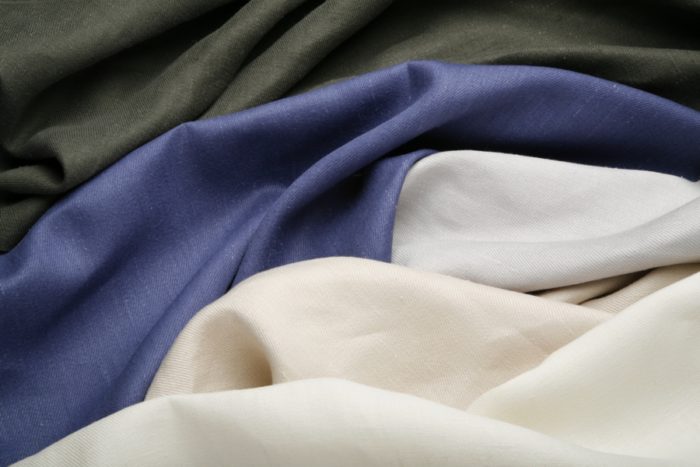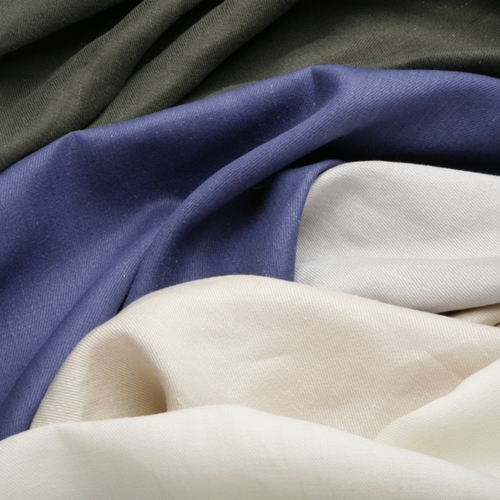
Image Credit: O Ecotextiles Inc.
As an eco-nerd at heart, I love researching and reading up on products. Here is what I’ve found when sourcing sustainable natural fibers for fabrics and rugs.
Organic cotton is grown without pesticides, herbicides, insecticides, or chemical fertilizers. It is grown and harvested using sustainable agricultural methods, which reduces/eliminates pests, enhances growth, maintains soil quality, and protects cotton harvesters. When grown organically, damage to the soil, environment, or human health is significantly less; plus, the fiber is stronger because of no chemical processing.
On the flip side, manufacturing organic cotton requires large amounts of water; when possible, look for crops from fields that receive sufficient rainfall to irrigate the crops.
Biologist Sally Fox developed colored organic cotton with fibers long enough to be spun into thread. It grows naturally in shades of green, brown, and natural, with the added benefit of being fade resistant.
Organic cotton is rapidly renewable, minimally processed, absorbent, reusable, recyclable, and, ultimately, biodegradable.
Organic wool harvested by sustainable ranchers is a strong, beautiful fiber with few limitations, plus amazing longevity and durability. Naysayers debate that sheep emit high levels of carbon dioxide and abuse the land. Wool also needs to be scoured, which requires significant amounts of water and leads to polluted waste water.
Ensure that the wool is unbleached or bleached with ozone-based products and dyed with responsible, eco-friendly methods rather than with heavy metal dyes.
Organic wool is rapidly renewable, minimally processed, absorbent, inherently fire retardant, stain resistant, reusable, recyclable, and, ultimately, biodegradable.
Soy silk is a by-product of the tofu-making process; the liquefied soy proteins are extruded into fibers, which are then spun into soft and lustrous textiles. Because of the high protein base, it takes well to natural dyes.
Legend has it that Henry Ford wore a suit made of soy silk in the 1940s, and Ford cars sported soy-fiber upholstery. I’ve yet to find upholstery fabrics made from soy silk—let me know if you come across a source—but they are just around the corner. I’ve knit with skeins of soy silk yarn and love the soft, luxurious texture.
Flax (aka linen) is created by processing, spinning, and weaving flax fibers (from the plant’s stem) into a strong, durable cloth. Linen keeps you cool and dry, absorbing moisture before feeling damp, and gets softer and stronger the more it is used. Another plus is that it is colorfast and nonallergenic.
Flax requires little water and fertilizers and is rapidly renewable, minimally processed, absorbent, reusable, recyclable, and, ultimately, biodegradable.
Ramie, also known as China grass, is a flowering plant native to Asia. It is one of the strongest fibers, highly absorbent, and naturally stain resistant.
Ramie is often blended with other fibers such as cotton and hemp to produce fabrics with enhanced durability.
Ramie grows with little water and fertilizers, is rapidly renewable, minimally processed, absorbent, reusable, recyclable, and, ultimately, biodegradable.
Bamboo is a renewable grass, which classifies it as eco-friendly. It has natural antibacterial properties and is hypoallergenic; plus, it drapes like silk but is more durable and less expensive.
“Panda-friendly’ bamboo plants are a must! These grow quickly without fertilizers or pesticides and require minimal amounts of water. The grasses also release 35% more oxygen into the air than an equivalent stand of trees. Bamboo fabric is created from the pulp of the stalk and readily accepts dyes, and there is no need for chlorine bleach.
The negative aspect of the process comes from the sulfuric acid used in the processing of the pulp. This contributes minimally to air pollution and the waste water and must be neutralized with bacteria before it is returned to the ecosystem.
Bamboo grows with little water and fertilizers, is rapidly renewable, absorbent, reusable, recyclable, and ultimately biodegradable.
Tencel is a newer fabric made from wood pulp cellulose. It is a branded lyocell fiber that comes from eucalyptus trees, which yield a high-quality fiber with less water from a fast-growing tree. (For an even greener product, look for trees that are certified by the Forest Stewardship Council (FSC).)
A nontoxic organic solvent is created from the wood pulp, which is than reclaimed and recycled in a closed-loop spinning process that conserves energy and water. Statistics show that up to 95% of the solvent is recovered and reused. Look for Tencel that does not utilize harmful chemicals (like formaldehyde) to treat the fibrillation of the fibers.
One of the drawbacks of Tencel and other lyocell-based fabrics is that that they don’t take well to dyes. This may lead to the use of a chemical-based dye process or other treatments that are not eco-friendly.
Tencel comes from a plant that requires little water and fertilizers and is rapidly renewable, reusable, recyclable, and, ultimately, biodegradable.
Jute comes from a flowering vegetable plant that grows to 10 feet tall. Historically, the plant fiber has been used to make rope, twine, carpet, and rugs. Jute, an inherently strong fiber, is one of the cheapest natural fibers available. It has also been used to make paper, geotextile (a fiberglass alternative), and particleboard.
More good news! Jute improves soil quality, is carbon dioxide neutral and 100% recyclable and biodegradable without causing environmental hazards.
Jute grows with little water and fertilizers and is rapidly renewable, minimally processed, absorbent, reusable, recyclable, and, ultimately, biodegradable.
Ingeo is the product of a joint venture between Cargill and Teijin. It is a man-made fiber made out of corn: The starch and sugars from corn is extracted and processed into a fiber, which is then spun into yarn or woven into fabric. Ingeo is an innovative material that is emerging as an eco-friendly alternative.
Ingeo is a trademark of NatureWorks LLC, which claims Ingeo to be the world’s first man-made fiber derived from 100% renewable resources. “Ingeo fiber combines the qualities of natural and synthetic fibers in a new way,” the company states. “Strength and resilience are balanced with comfort, softness, and drape in textiles. In addition, Ingeo fiber has good moisture management characteristics. This means that Ingeo fiber is ideally suited to fabrics from fashion to furnishings.”
The fabric absorbs odors and is stain and fade resistant and hypoallergenic, but it doesn’t retain moisture.
Hemp may be last in this list, but certainly not least! Let’s take a look at one of my favorite kinds—cannabis—cultivated for nondrug use into industrial hemp. Hemp is a multiuse natural fiber with remarkable benefits and attributes. Its long strands of fiber are suitable for spinning with minimal processing, creating the strongest of the natural fibers.
Hemp is gaining status as an environmentally friendly alternative, with a beautiful hand, feel, and drape. It grows quickly and densely, eliminating the need for herbicides, pesticides, and artificial fertilizers, and it needs no irrigation, as it flourishes on average rainfall.
Hemp comes in an assortment of textures and weights; it can be found in woven or knit fabrics, ropes, belts, area rugs and carpets; plus, it is insect and mildew resistant.
Hemp, currently imported from China, is still illegal to grow in many areas of the world, being confused with the marijuana plant. Advocates and stakeholders are working with legislators toward changing current laws.
Hemp grows with little water and fertilizers and is rapidly renewable, minimally processed, absorbent, reusable, recyclable, and, ultimately, biodegradable.
Weekly Newsletter
Get building science and energy efficiency advice, plus special offers, in your inbox.










0 Comments
Log in or create an account to post a comment.
Sign up Log in